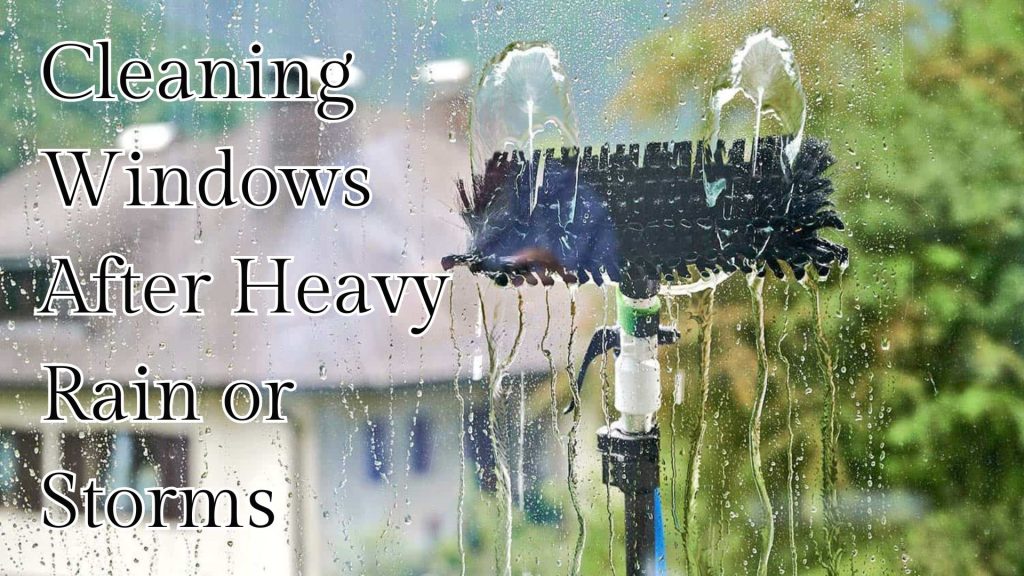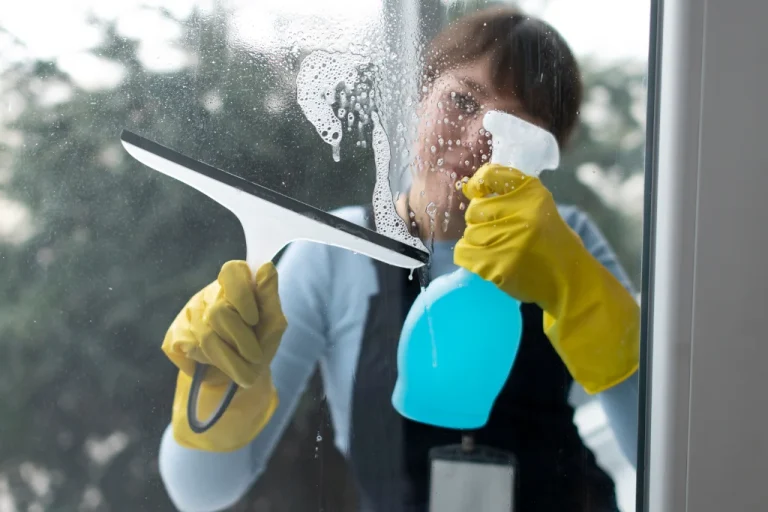Table of Contents
Introduction:
Australia’s diverse climate presents unique challenges when it comes to keeping window clean. From the dry, dusty conditions in the outback to the humid, storm-prone coasts, maintaining clear, sparkling and clean windows requires tailored strategies. This guide will provide practical tips on how to keep your windows looking their best despite the weather.

Dealing with Dust and Pollen During Dry Seasons
Dry seasons can cause dust and pollen to accumulate on your windows, particularly in Australia’s more arid regions:
- Regular Dusting: Dust your windows and frames weekly with a microfiber cloth to prevent buildup.
- Use a Damp Cloth: For more stubborn dust, lightly dampen your cloth with water or a mild cleaning solution to wipe down the glass and frames.
- Install Fly Screens: Fly screens can help reduce the amount of dust and pollen that settles on your windows, especially in rural areas.
- Plant Windbreaks: If you live in a particularly dusty area, consider planting shrubs or trees near your home to act as natural windbreaks, reducing the amount of dust that reaches your windows. By addressing dust and pollen regularly, you can keep your windows clear and reduce the need for frequent deep cleaning.
[lead-form form-id=1 title=Fill to Get Free Cleaning Checklist]
Cleaning Windows After Heavy Rain or Storms
Rain and storms can leave your windows streaked with water spots and dirt:
- Clean Immediately: Wipe down your windows as soon as possible after a storm to prevent water spots from setting in.
- Use a Squeegee: A squeegee is ideal for quickly removing water from the glass and reducing the risk of streaks.
- Check for Debris: After a storm, check your window sills and frames for leaves, dirt, or other debris that may have been blown in, and clean them promptly.
- Apply a Water Repellent: Consider applying a water-repellent treatment to your windows to help rainwater slide off more easily and reduce spotting. Regular maintenance after rain will keep your windows looking clear and prevent long-term damage from water exposure.

How to Prevent Water Spots and Stains
Water spots and stains are common issues, especially in areas with hard water or high humidity:
- Use Distilled Water: If your tap water is hard, mix your cleaning solution with distilled water to prevent mineral deposits from forming on your glass.
- Dry Thoroughly: After cleaning, always dry your windows thoroughly with a microfiber cloth or squeegee to remove all moisture.
- Apply a Protective Coating: Products like Rain-X can be applied to windows to create a barrier that helps repel water and reduces the likelihood of spots forming.
- Wipe Down After Showers: If you have windows in your bathroom, wipe them down after showers to prevent water spots and mineral buildup. Preventing water spots requires consistent care but results in longer-lasting clarity for your windows.

Protecting Windows from Australia’s Harsh Sunlight
Australia’s intense sunlight can cause damage to windows over time, including fading and warping:
- Use UV-Protective Films: Apply UV-protective window films to reduce the impact of sunlight on both your windows and the interior of your home.
- Install Awnings or Shades: Exterior awnings or interior shades can help shield your windows from direct sunlight, reducing the risk of damage.
- Clean Regularly: Sunlight can bake dirt and grime onto your windows, making it harder to clean later. Regular cleaning prevents buildup.
- Choose UV-Resistant Glass: When replacing windows, consider UV-resistant glass that offers better protection against Australia’s harsh sunlight. Taking steps to protect your windows from UV damage can extend their lifespan and keep your home cooler.
You may also like to read about-“4 Tips and Tricks for Maintaining and Cleaning Windows
Seasonal Maintenance Tips for Australian Homeowners
Each season in Australia presents different challenges for window maintenance. Here’s how to prepare for each one:
- Spring: Focus on removing the dust and pollen that accumulated during the dry season. This is also a good time to clean screens and repair any damage.
- Summer: Protect your windows from intense sunlight with UV films and keep them clean to prevent sun-baked dirt.
- Autumn: As temperatures cool, clean windows to remove any buildup from the summer and prepare for the wetter months ahead.
- Winter: Keep windows clean and free from condensation by regularly wiping down glass and frames. By adjusting your window maintenance routine seasonally, you can keep your windows looking their best year-round.

The Importance of Regular Cleaning in Coastal Areas
Coastal areas pose unique challenges due to the presence of salt, humidity, and sand:
- Rinse Windows Regularly: Salt can corrode window frames and glass, so it’s essential to rinse your windows regularly with fresh water.
- Use a Vinegar Solution: Vinegar is effective at cutting through salt buildup on windows. Mix one part vinegar with one part water for an effective cleaner.
- Protect Frames: Consider applying a protective sealant to your window frames to prevent corrosion caused by salty air.
- Inspect for Damage: Regularly inspect your windows and frames for signs of damage from the coastal environment, and address any issues promptly. Regular maintenance in coastal areas is crucial to prevent long-term damage and maintain the appearance of your windows.
You may also like to read about-“What cleaning solution is used on high rise windows?
Using Protective Coatings for Long-Lasting Shine
Protective coatings can help extend the life of your window cleaning efforts and reduce the frequency of maintenance:
- Hydrophobic Coatings: These coatings repel water, making it easier for rain to slide off and preventing water spots from forming.
- Anti-Static Coatings: Anti-static coatings help reduce the amount of dust and dirt that clings to windows, keeping them cleaner for longer.
- UV-Resistant Coatings: Protect your windows from the damaging effects of the sun with UV-resistant coatings, which also help prevent fading of interior furnishings.
- Apply After Cleaning: Apply these coatings immediately after a thorough cleaning to ensure the best adherence and longevity. Using protective coatings can significantly reduce the time and effort needed to keep your windows looking pristine.
You may also like to read about-“Unveiling the Secrets of Spotless Windows: Expert Tips from Window Cleaning Services”
How to Keep Windows Clean Year-Round
Maintaining clean windows throughout the year requires a combination of regular maintenance and smart strategies:
- Set a Schedule: Create a window cleaning schedule that suits your climate and stick to it, adjusting as needed for seasonal changes.
- Use the Right Tools: Invest in quality tools like squeegees, microfiber cloths, and extension poles to make regular cleaning easier.
- Monitor Weather Conditions: Plan your cleaning around weather patterns, avoiding times when dust, pollen, or storms are prevalent.
- Keep Screens Clean: Regularly clean window screens to prevent them from transferring dirt onto your windows. With consistent care and attention, you can enjoy clear, beautiful windows no matter the season.
Conclusion:
Maintaining clean windows in Australia’s diverse climate requires a tailored approach that takes into account the challenges posed by dust, rain, sunlight, and coastal conditions. By following these tips and incorporating regular maintenance into your routine, you can keep your windows looking their best all year round. Whether you choose to handle the cleaning yourself or enlist the help of professionals, a little effort goes a long way in preserving the clarity and appearance of your windows.




